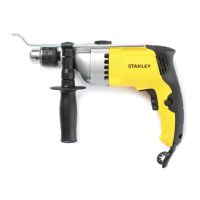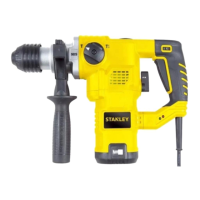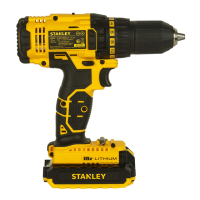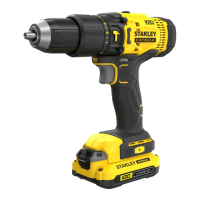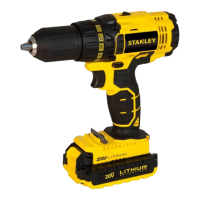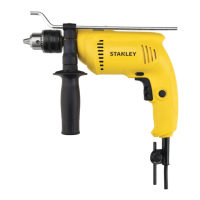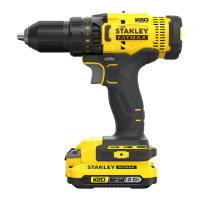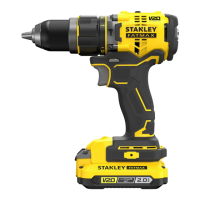12 • ENGLISH
The charge is complete when the charging indicator (11)
lights green continuously. The charger and the battery can
be left connected indefinitely with the LED illuminated.
The LED will change to flashing green (charging) state as
the charge occasionally tops up the battery charge. The
charging indicator (11) will be lit as long as the battery is
connected to the plugged-in charger.
f Charge discharged batteries within 1 week. Battery
life will be greatly diminished if stored in a discharged
state.
Leaving the battery in the charger
The charger and battery pack can be left connected with
the LED glowing indefinitely. The charger will keep the
battery pack fresh and fully charged.
Charger diagnostics
If the charger detects a weak or damaged battery, the
charging indicator (11) will flash red at a fast rate. Proceed
as follows:
f Re-insert the battery (5).
f If the charging indicators continues flashing red at a
fast rate, use a different battery to determine if the
charging process works properly.
f If the replaced battery charges correctly, the original
battery is defective and should be returned to a
service centre for recycling.
f If the new battery gives the same indication as the
original battery, take the charger to be tested at an
authorised service centre.
Note: It may take as long as 60 minutes to determine
that the battery is defective. If the battery is too hot
or too cold, the LED will alternately blink red, fast and
slow, one flash at each speed and repeat.
Selecting the direction of rotation (Fig. F)
For drilling and for tightening screws, use forward
(clockwise) rotation. For loosening screws or removing a
jammed drill bit, use reverse (counterclockwise) rotation.
f To select forward rotation, push the forward/reverse
slider (2) to the left.
f To select reverse rotation, push the forward/reverse
slider to the right.
f To lock the tool, set the forward/reverse slider into the
centre position.
Selecting the torque
This tool is fitted with a collar to set the torque for various
screwdriving and drilling applications. Large screws and
hard workpiece materials require a higher torque setting
than small screw and soft workpiece materials. For the
definition of the symbol refer to the listing below.
f For drilling in wood, metal and plastics, set the torque
adjustment collar (4) to the symbol.
f For screwdriving, set the collar to the desired setting.
If you do not yet know the appropriate setting,
proceed as follows:
- Set the torque adjustment collar (4) to the lowest
torque setting.
- Tighten the first screw.
- If the clutch ratchets before the desired result
is achieved, increase the collar setting and
continue tightening the screw. Repeat until you
reach the correct setting. Use this setting for the
remaining screws.
Speed selector
f For drilling in steel and for screwdriving applications,
slide the speed selector (8) towards the rear of the
tool (1st gear).
f For drilling in materials other than steel, slide the
speed selector (8) towards the front of the tool (2nd
gear).
Drilling/screwdriving
f Select forward or reverse rotation using the forward/
reverse slider (2).
f To switch the tool on, press the switch (1). The tool
speed depends on how far you press the switch.
f To switch the tool off, release the switch.
LED work light
The LED work light (7) is activated automatically when
the trigger is depressed. The LED work light will illuminate
when the trigger is partially depressed, before the unit
begins running.
HINTS FOR OPTIMUM USE
Drilling
f Always apply a light pressure in a straight line with
the drill bit.
f Just before the drill tip breaks through the other side
of the workpiece, decrease pressure on the tool.
f Use a block of wood to back up workpieces that may
splinter.
f Use spade bits when drilling large diameter holes in
wood.
f Use HSS drill bits when drilling in metal.
f Use masonry bits when drilling in soft masonry.
f Use a lubricant when drilling metals other than cast
iron and brass.
f Make an indentation using a centre punch at the
centre of the hole to be drilled in order to improve
accuracy.
Screwdriving
f Always use the correct type and size of screwdriver bit.
f If screw are difficult to tighten, try applying a small
amount of washing liquid or soap as a lubricant.
